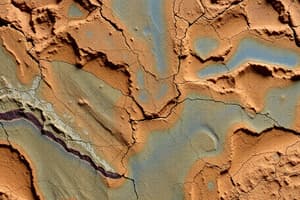Podcast
Questions and Answers
When scientists aim to establish the age of a newly discovered fossil in a rock layer, which approach is most efficient and accurate?
When scientists aim to establish the age of a newly discovered fossil in a rock layer, which approach is most efficient and accurate?
- Rely solely on stratigraphic succession for a definitive age estimate.
- First use relative dating to narrow down the age range, then radiometric dating for accuracy. (correct)
- Immediately apply radiometric dating for a precise age determination.
- Prioritize fossil succession and disregard radiometric dating due to its complexity.
What is the primary advantage of using relative dating methods in geological studies?
What is the primary advantage of using relative dating methods in geological studies?
- Determining the absolute age of fossils without laboratory analysis.
- Providing exact numerical ages for rock formations.
- Identifying the specific radioactive isotopes present in a rock sample.
- Establishing the chronological order of geological events and rock layers efficiently. (correct)
For which of the following scenarios would numerical dating be most essential in geological research?
For which of the following scenarios would numerical dating be most essential in geological research?
- Establishing that a fault is younger than the rock layers it cuts through.
- Comparing the age of a volcanic rock layer to an overlying sandstone layer.
- Determining the order in which different sedimentary layers were deposited in a canyon.
- Estimating the approximate age of a hominid fossil found within a specific rock stratum. (correct)
Why is it stated that we will 'never know exactly' the age of Paul's dinosaur, even with scientific dating methods?
Why is it stated that we will 'never know exactly' the age of Paul's dinosaur, even with scientific dating methods?
In typical geological investigations, why do scientists often prefer to use relative dating methods before numerical dating techniques?
In typical geological investigations, why do scientists often prefer to use relative dating methods before numerical dating techniques?
Flashcards
Relative Dating
Relative Dating
Determining the age of rocks/fossils relative to each other without exact dates.
Numerical Dating
Numerical Dating
Assigning specific dates or age ranges to rocks/fossils, often using radiometric methods.
Stratigraphic Succession
Stratigraphic Succession
Sedimentary layers are deposited in a time sequence, with the oldest at the bottom and the youngest at the top.
Fossil Succession
Fossil Succession
Signup and view all the flashcards
Combined Dating
Combined Dating
Signup and view all the flashcards
Study Notes
- Scientists combine relative and numerical dating to determine the ages of rocks and fossils.
- Radiometric dating on every rock would be too costly and take too long.
- Relative dating is used to get a general idea of age.
- Numerical dating is used for specific items like fossils.
- Paul likely estimated superus awesomus to be 150 to 200 million years old using stratigraphic and fossil succession.
- Radiometric dating of the fossil gave a more precise age of 175 million years.
- Relative dating is used to determine the age of rocks in relation to each other worldwide.
- Numerical dating is used to approximate the actual ages of rocks.
- Although the exact age of Paul's dinosaur cannot be known, scientists can be reasonably confident in age estimations due to the work of geologists, paleontologists, chemists, and physicists, using numerical and relative dating techniques.
Studying That Suits You
Use AI to generate personalized quizzes and flashcards to suit your learning preferences.




